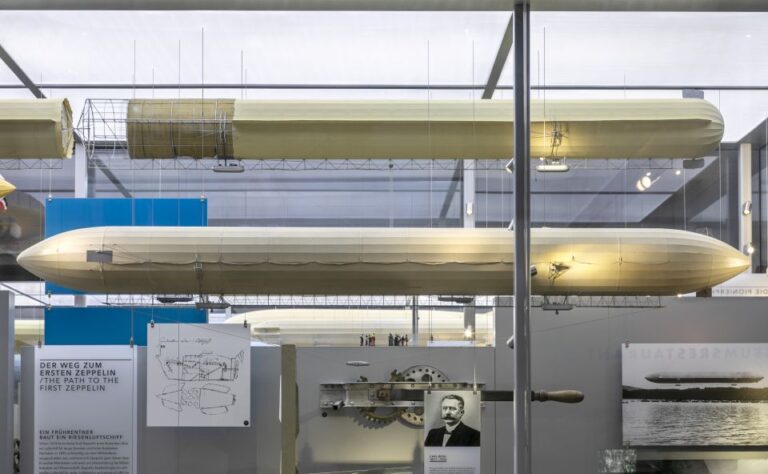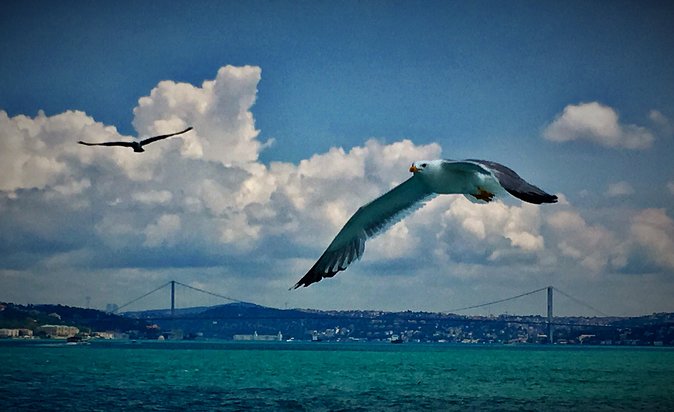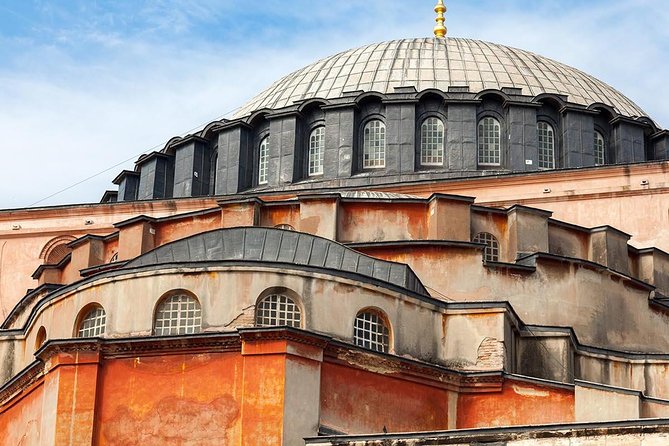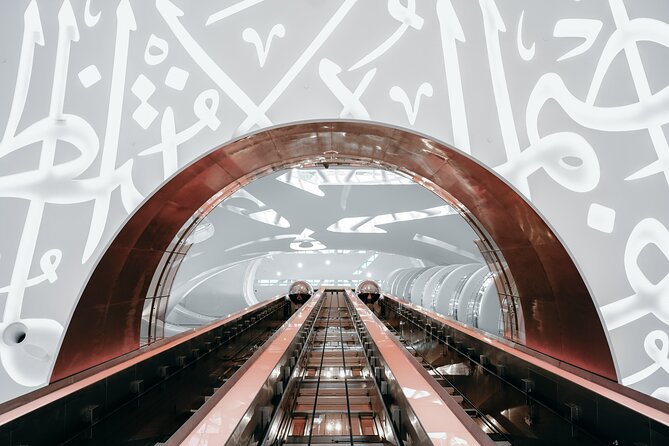Spread out over 7 million square feet, Topkapı Palace (Topkapı Sarayı) is the highlight of any trip to Istanbul. This sprawling estate, built in the 15th century on the site of an ancient acropolis, served as the administrative, educational, and art center of the Ottoman Empire for nearly 400 years.
Converted into a museum in 1924, Topkapı became the first museum in the newly formed Republic of Turkey and remains a major tourist attraction today.
The Imperial Gate and First Courtyard
The palace grounds, divided into four sections, are accessible via the imposing Imperial Gate. One of three ceremonial gates, it dates back to the second half of the 15th century during the reign of Sultan Mehmet the Conqueror. Both the exterior and interior facades of the gate are inscribed with verses from the Koran and the signature of Sultan Abdülaziz.
Once through the Imperial Gate, you’ll find yourself in the outer courtyard, commonly referred to as the First Courtyard. The largest of the three palace courtyards, this area was the only space open to the public and served as a waiting area during important events. In this courtyard, you’ll see:
Hagia Eirene (Aya Irini)
This 6th-century church stands on the site of a much earlier Christian church established during the reign of Constantine. Following the conquest of the city by the Ottoman Empire, Hagia Eirene was used for a time as a weapons depot and military museum. The church now serves as a venue for concerts and art exhibits (separate admission fee applies).
Ticket Office
Located along the wall to your right, purchase your Topkapı Palace and Harem entry tickets here.
Gate of Salutation
Serving as the portal to the Second Courtyard, this middle gate was built in the mid-15th century. Today, it is the main visitors’ entrance to the palace museum. Decorative features on the Salutation Gate include the official signature (tuğra) of sultans Mahmud II and Mustafa III.
The Second Courtyard (Divan Square)
Passing through the Gate of Salutation, you’ll enter the Second Courtyard, also known as Divan Square, completed in the early 16th century. This area served as the location of the administrative center of the Empire. The courtyard, surrounded by arcades, is where official ceremonies took place. Here you’ll see:
Divan Lounge (Divanhane)
Also known as the Council Hall, this is where the Grand Viziers (Prime Ministers) received foreign ambassadors, where the wedding ceremonies of the Sultan’s daughters took place, and where state affairs and judicial matters were handled. The current chamber, built in the 16th century, was renovated to its current look in the 18th century. Notice the rococo-style accents on the gilded screens and doors at the entrance.
Note: Behind the Divan Lounge is the entrance to the Harem. A separate ticket is required for access to the Harem.
Tower of Justice
This 15th/16th-century palace tower served as an observation point for the sultan.
Outer Treasury
The former official state treasury, now a weapons gallery, was originally constructed in the 15th century and rebuilt in the 16th century.
The Palace Kitchens
Located to your right upon entering the courtyard, the kitchens, recently opened to visitors, house pieces from the royal porcelain collection.
The Gate of Felicity
This 15th-century gate with 18th/19th-century decorative features served as the official entrance to the Sultan’s private chambers around the Inner Court, also known as the Third Courtyard.
Guarded by the Eunuchs of the Harem, this gate was used primarily by the sultan for special events, such as coronation ceremonies, and anyone wishing to pass through was required to have the permission of the Sultan.
The Third Courtyard
From here, enter the 15th-century Third Courtyard, where you’ll find:
The Audience Chamber
Also known as the Chamber of Petitions, this hall is located just past the Gate of Felicity and was historically known as the High Office. It served as a receiving room where the Sultan met with foreign ambassadors and consulted with state officials.
Library of Ahmet III
Built in the 18th century on the site of a former Pool Pavilion, the library was established for the benefit of the Enderûn Palace School and decorated inside with tiles recycled from various mansions and palaces in Istanbul.
The Dormitory of the Expeditionary Force
The current structure, built on the site of the Sultan’s bath, dates to the 18th century (the previous dormitory here to the 17th century). The dormitory now houses the Imperial Wardrobe Collection, consisting of about 2,500 garments, the majority of which are the kaftans worn by the Sultans.
Mehmet II Pavilion
Also known as the Conqueror’s Kiosk, this is one of the oldest sections of Topkapı Palace, dating to the mid-15th century. It served for a time as the treasury, for safekeeping of valuables, and included a jewelry workshop.
Treasury Ward
Founded by Sultan Mehmet the Conqueror and administered by the ‘guardians of the treasury’, whose main tasks included keeping inventory.
The Privy Chamber (Has Oda)
Built as a private mansion for the sultans in the 15th century, the various rooms here include the Hall with the Fountain (named for the marble fountain under the dome), the Presentations Room (Arz-han), and the Throne Room (Taht Odası). The Privy Chamber also houses the Chamber of the Holy Relics. Displayed here are the sacred relics collected by the sultans over the centuries, including:
- The Holy Mantle or Mantle of Felicity (Hırka-i Saadet), believed to have been worn by the Prophet Muhammad
- A strand of hair from the Prophet’s beard and a reliquary which holds his tooth
- A tray used by Abraham
- A sword said to have belonged to David
- A robe that belonged to Joseph
Note: Due to the importance of the relics and the shrine-like nature of the displays, the line to enter the Privy Chamber can be really long and moves slowly through the gallery. If religious relics are not your thing and the line is long, consider skipping the Privy Chamber/Relics Chamber or come back when the line is shorter.
Dormitory of Privy Chamber
Currently used for the exhibit of the Portraits of the Sultans.
The Mosque of the Squires (Ağalar Camii)
The largest mosque in the palace and one of the oldest (dating to the 15th century), decorated with tiles from the 17th century.
The Fourth Courtyard
From the Third Courtyard, make your way via the passage between the buildings to the unofficial Fourth Courtyard of the Sultan’s private quarters. Step out to the Pond Terrace with its decorative pool, surrounded by several pavilions, including:
The Baghdad Kiosk (Bağdad Köşkü)
A 17th-century pavilion built to commemorate the Baghdad campaign of Sultan Murat IV, used for a time as a library. Notice the interesting interior, which features wooden cabinets inlaid with mother of pearl, ivory, and tortoiseshell; a gilded fireplace; and a silver charcoal stove (mangal) said to have been a gift from King Louis XIV.
Iftariye Pavilion
Sometimes referred to as the “Moonlit Seat”, this gilded pavilion sits at the edge of the Pond Terrace. Dating from the 17th century, this is where the sultans reportedly broke their fast in the evenings during Ramadan.
Circumcision Room
Dating, it’s believed, to the reign of Suleyman the Magnificent, this pavilion was intended as the Sultan’s summer kiosk and came to be used for circumcision ceremonies.
Mustafa Pasha Kiosk
Also known as the Sofa Pavilion, it was built in the 17th century and consists of the Divan Lounge (Divanhane) and Sherbet Room (Şerbet Odası). Here, the sultans sat to talk, hold meetings, and watch live sporting events.
The Revan Pavilion
Built in the early 17th century to commemorate the conquest of Yerevan (Revan), this pavilion served as a library and for a time held the sacred relics collected by the sultans.
Getting There and Ticket Info
- Location: Topkapı Palace (Topkapı Sarayı) is located on the tip of the peninsula in the Sultanahmet neighborhood, directly behind Hagia Sophia.
- Ticket Prices:
- Adult Admission (Palace) = 30.00 TL
- Adult Admission (Harem) = 15.00 TL
- Adult Admission (Hagia Eirene) = 20.00 TL
Travel Tips
- Restorations of the Topkapı Palace chambers are ongoing, so some galleries/pavilions may be closed at the time of your visit.
- We do not recommend purchasing anything from the palace café/restaurant, as the prices here are extremely inflated.
Additional Information
- Topkapı Palace was the primary residence of the Ottoman Sultans for approximately 400 years (1465-1856) of their 624-year reign.
- The palace complex consists of four main courtyards and many smaller buildings, covering a total area of 700,000 square meters (7,535,000 square feet).
- At its peak, the palace was home to as many as 4,000 people and served as a royal residence, administrative hub, and seat of government for the Ottoman Empire.
- The palace’s architecture is predominantly Middle Eastern in character, with some Byzantine influences visible in the earlier constructions and later European influences in the newer sections.
- The palace became a museum in 1924, a year after the hotel of the Republic of Turkey.
- The palace collection includes Ottoman clothing, weapons, armor, miniatures, religious relics, and illuminated manuscripts, as well as a large collection of Chinese and Japanese porcelain, European porcelain, and glass.
Tips for Your Visit
- Allow at least 3-4 hours to explore the palace, as there is a lot to see and the grounds are extensive.
- Wear comfortable shoes, as you’ll be doing a lot of walking on uneven surfaces and up and down stairs.
- Be prepared for crowds, especially during peak tourist season. Consider visiting early in the day or later in the afternoon to avoid the largest groups.
- If you’re interested in visiting the Harem, be sure to purchase a separate ticket at the entrance, as this area is not included in the general palace admission.
- Audio guides are available for rent at the entrance, which can provide valuable insights into the palace’s history and the significance of the various buildings and artifacts.
- Don’t miss the views from the Fourth Courtyard, which offer stunning panoramas of the Bosphorus and the Asian side of Istanbul.
A visit to Topkapı Palace is an essential part of any trip to Istanbul. This vast complex offers a fascinating glimpse into the lives of the Ottoman Sultans and the rich history of the empire they ruled. From the grand ceremonial spaces of the Second Courtyard to the intimate private quarters of the Fourth Courtyard, Topkapı Palace is a testament to the power, wealth, and sophistication of one of the world’s greatest empires. Whether you’re a history buff, an architecture enthusiast, or simply a curious traveler, a tour of this magnificent palace is sure to be a highlight of your time in Istanbul.






